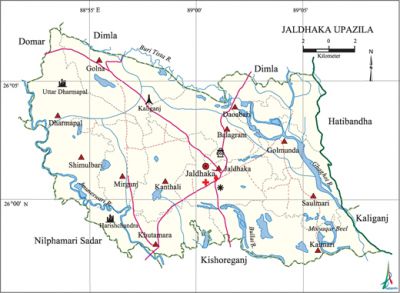Jaldhaka Upazila
Jaldhaka Upazila (nilphamari district) area 303.51 sq km, located in between 25°57' and 26°07' north latitudes and in between 88°50' and 89°07' east longitudes. It is bounded by dimla upazila on the north, kishoreganj (nilphamari) upazila on the south, hatibandha and kaliganj (lalmonirhat) upazilas on the east, nilphamari sadar and domar upazilas on the west.
Population Total 340672; male 171466, female 169206; Muslim 273924, Hindu 66583, Buddhist 1, Christian 60 and others 104.
Water bodies Main rivers: tista, Jamuneshwari, Bullai, ghaghat; Moiya Beel and Gabrail Beel are notable.
Administration Jaldhaka Thana was formed in 1911 and it was turned into an upazila in 1983.
| Upazila | ||||||||
| Municipality | Union | Mouza | Village | Population | Density (per sq km) | Literacy rate (%) | ||
| Urban | Rural | Urban | Rural | |||||
| 1 | 11 | 61 | 61 | 46211 | 294461 | 1122 | 41.5 | 37.3 |
| Municipality | ||||||||
| Area (sq km) |
Ward | Mahalla | Population | Density (per sq km) |
Literacy rate (%) | |||
| 28.20 | 9 | 12 | 46211 | 1639 | 41.5 | |||
| Union | ||||
| Name of union and GO code | Area (acre) | Population | Literacy rate (%) | |
| Male | Female | |||
| Kanthali 58 | 5366 | 12748 | 12705 | 38.8 |
| Kaimari 51 | 8548 | 20039 | 20318 | 41.4 |
| Khutamara 65 | 6555 | 17111 | 16992 | 33.3 |
| Golna 36 | 7539 | 13488 | 13034 | 39.4 |
| Golmunda 29 | 3865 | 13718 | 13183 | 32.8 |
| Daoabari 14 | 5499 | 6390 | 6125 | 30.7 |
| Dharmapal 21 | 6392 | 12337 | 11902 | 38.6 |
| Balagram 13 | 6662 | 14126 | 14248 | 40.8 |
| Mirganj 80 | 5342 | 13230 | 13127 | 33.1 |
| Shimulbari 87 | 6200 | 12355 | 12151 | 41.8 |
| Saulmari 94 | 6063 | 12431 | 12703 | 35.4 |
Source Bangladesh Population Census 2011, Bangladesh Bureau of Statistics.

Archaeological heritage and relics Garh (fort) of Raja Dharmapal (Dharmapal union), ritual Pot of Raja Harishchandra (Khutamara union), Bhimer Dhap in Golna union.
War of Liberation The Pak army established a camp at the Jaldhaka High School in 1971; they used to capture innocent persons from the nearby locality with the help of the local razakars and brutally killed them. Freedom fighters of the upazila had an encounter with the Pak army at Golmunda Razakar camp. Mass graves have been found at two places (Kaliganj and at the backyard of Jaldhaka High School) of the upazila.
For details: see জলঢাকা উপজেলা, বাংলাদেশ মুক্তিযুদ্ধ জ্ঞানকোষ (Encyclopedia of Bangladesh War of Liberation), বাংলাদেশ এশিয়াটিক সোসাইটি, ঢাকা ২০২০, খণ্ড ৪।
Religious institutions Mosque 317, tomb 2, temple 25, sacred place 1.
Literacy rate and educational institutions Average literacy 37.9%; male 41.4%, female 34.4%. Noted educational institutions: Jaldhaka Degree College (1972), Rabeya Chowdhury Women's Degree College (1994), Jaldhaka Business Management Institute (1995), Jaldhaka Pilot High School (1917), Shimulbari SC High School, Jaldhaka Model Government Primary School (1940), Golmunda Fazil Madrasa (1919).
Newspapers and periodicals Weekly: Jalkatha, Jaltaranga.
Cultural organisations Library 2, club 19, theatre group 2, theatre stage 1, women's organisation 64, playground 45, music academy 2.
Main sources of income Agriculture 80.15%, non-agricultural labourer 2.54%, commerce 8.38%, transport and communication 2.06%, service 3.05%, construction 0.52%, religious service 0.15%, rent and remittance 0.10% and others 3.05%.
Ownership of agricultural land Landowner 60.09%, landless 39.91%; agricultural landowner: urban 67.04% and rural 59.67%.
Main crops Paddy, tobacco, wheat, potato, jute, maize, vegetables.
Extinct or nearly extinct crops Sesame, linseed, china, barley, kaun, sweet potato, arahar, karpas cotton.
Main fruits Jackfruit, mango, black berry, banana, papaya, litchi.
Fisheries, dairies and poultries Fishery 2440, dairy 28, poultry 12, nursery 35.
Communication facilities Pucca road 169.49 km, mud road 563.46 km.
Extinct or nearly extinct traditional transport Palanquin, horse carriage, bullock cart.
Noted manufactories Rice mill, flour mill, ice factory, saw mill, cold storage, welding factory.
Cottage industries Goldsmith, blacksmith, potteries, weaving, bamboo work and wood work.
Hats, bazars and fairs Hats and bazars are 85, fairs 3, most noted of which are Jaldhaka, Mirganj and Kaimari Hats; Tatua Mela and Balagram Chandihati Mela.
Main exports Tobacco, maize, vegetables.
Access to electricity All the unions of the upazila are under rural electrification net-work. However 26.2% of the dwelling households have access to electricity.
Sources of drinking water Tube-well 97.8%, tap 0.1% and others 2.1%.
Sanitation 33.9% of dwelling households of the upazila use sanitary latrines and 50.3% of dwelling households use non-sanitary latrines; 15.8% of households do not have latrine facilities.
Health centres Upazila health complex 1, family planning centre 10, satellite clinic 3, leprosy treatment centre 1.
Natural disasters Many people of the upazila were victims of the great famine of 1943. Besides, the flood of 1998 caused heavy damages to settlements, lovestock, crops and other properties of the upazila.
NGO activities Operationally important NGOs are brac, asa, CARE, Jaldhaka Samaj Kalyan Sangstha. [Bibekananda Mahanta]
References Bangladesh Population Census 2001 and 2011, Bangladesh Bureau of Statistics; Cultural survey report of Jaldhaka Upazila 2007.
